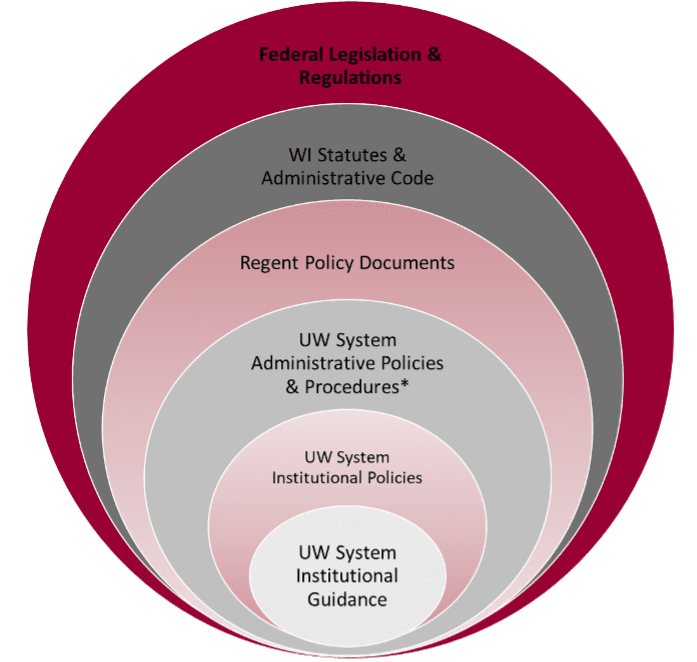Optimizing the policy development process in the University of Wisconsin System
Stefan Fletcher
Director of Administrative Policy, University of Wisconsin System
The views and opinions expressed are those of the author and do not necessarily represent the views or opinions of EAB.
In 2016, UW System began the process of revamping its approach to system-wide policy development. This initiative focused on the UW System administrative policies, which are system-wide policies approved by the UW System president that guide campus activities, ranging from tuition and fees to study abroad and program array planning. The UW System introduced a standard policy template and created an integrated policy set while establishing cross-unit policy teams and providing continual guidance to campuses on upcoming policy development priorities.
Challenges remain due to scale (the UW System is a 13-university system across 26 campuses), policy environment complexity (see diagram below showing the numerous layers of law, regulation and policy that affect university life, operations, and finances), and the connection of system-wide policies with major initiatives.

Capstone project
My capstone project focused on how the UW System could further optimize its policy development process to best serve campus stakeholders and system-level policy owners who are responsible for policy content, implementation, and oversight.
Due to the complexity noted above, there is a need to ensure we maintain focus on overarching policy accessibility, alignment, transparency, and equity across the UW System administrative policies (that our office helps to support policyowners with).
Solutions
While there isn’t one solution to tackle the challenges presented, I identified four ways to focus on issues-such as student success and equity-while also engaging in process improvement with respect to our policy review. Presentations and materials from EAB during the fellowship program further informed these four areas.
1. Student success and policy prioritization
In this year’s policy prioritization process, we borrowed from EAB’s work on reducing administrative and financial barriers to student success. We encouraged institutions to focus on real/perceived barriers when submitting their recommendations for policy priorities by adding a prompt to our campus input survey.
The policy office team is reviewing campus feedback, primarily sought through campus leadership (chancellors/provosts/CBOs, etc.), and incorporating it into the FY 2023 policy priority plan as a point of emphasis. The goal was to have UWSA policy owners consider new policies and/or policy revisions that were suggested by campuses and focus on them in the coming year.
2. Policy owner survey
We asked policy owners how satisfied they were with various aspects of the current policy development process (e.g., communication, timeliness, etc.) and if we could do anything to help them with their responsibilities for policy development, implementation, and oversight.
We are making changes to the training provided to policy owners to support them in the understanding of how to successfully work through the process and of their own responsibilities in collaborating with campuses. This included creating an orientation packet for new policy owners and highlighting how any institutional feedback on proposed policy changes were addressed by the policy owner to increase transparency. These changes went into effect in June.
3. Policy alignment (ATP)
The Administrative Transformation Program (ATP) is a UW System multi-year project to standardize finance, human resources, and research administration business processes and implement integrated, cloud-based technology systems at all UW System campuses. ATP will lead to significant business process changes that necessitate policy updates. I discussed with ATP staff a policy process pathway, including a shared emphasis on the removal of obsolete or redundant policies, as well as not creating new policies unless necessary. This will be ongoing work over the next year or so.
My thinking about ATP and the potential approach to policy changes is informed by EAB’s Five-Step Recipe for Process Improvement and mitigating some of the cultural, psychological, and structural barriers to strategy that we discussed in our prior session on barriers to change. This focus links well with a project our office is undertaking on interconnectedness mapping to help policyowners understand the full ecosystem of policy relationships when revising or developing policies.
4. Equity lens review
In 2019, UW introduced an equity lens into its policy development work. In this context, an equity lens is “a process for analyzing or diagnosing the impact of the design and implementation of policies on under-served, marginalized, and diverse individuals and groups and to identify and potentially reduce or eliminate barriers,” according to the University of Minnesota.
As part of our review, we will use the Five-Step Recipe for Process Improvement to bring together the campus senior diversity officers to ask how well the equity lens process is working for them and how we might bring forth an improved future state that fulfills the initial objectives for the equity lens initiative. Discussions will begin in July with the senior diversity officers.
More Blogs

What our global partners asked us most in 2025

Is your yield rate okay?
